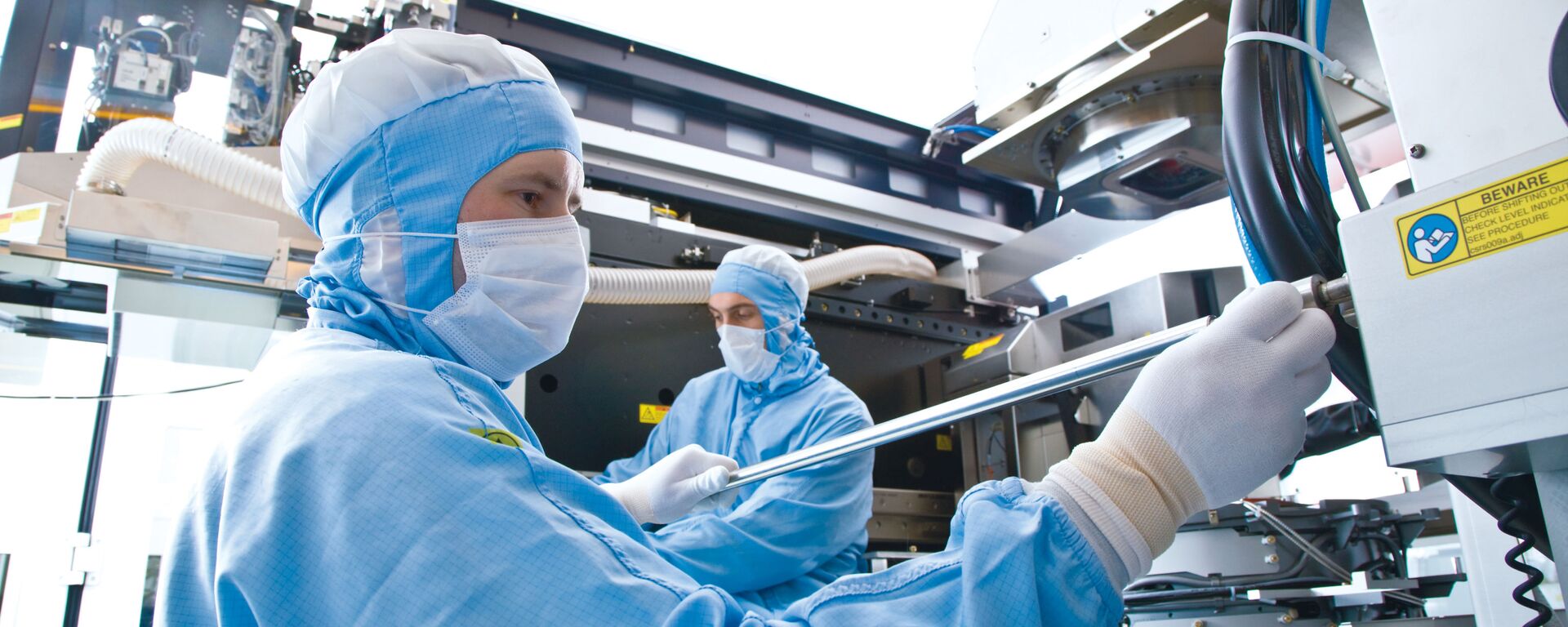https://sputnikglobe.com/20220816/why-us-restrictions-cant-stop-chinas-semiconductor-industry-advance-1099653996.html
Why US Restrictions Can't Stop China's Semiconductor Industry Advance
Why US Restrictions Can't Stop China's Semiconductor Industry Advance
Sputnik International
The Biden administration announced last week that it would impose export controls on cutting-edge technologies, including electronic design automation (EDA) to... 16.08.2022, Sputnik International
2022-08-16T13:51+0000
2022-08-16T13:51+0000
2022-08-16T13:51+0000
science & tech
us
asia
china
chips
processor
semiconductor manufacturing international corp (smic)
huawei
joe biden
us sanctions
https://cdn1.img.sputnikglobe.com/img/07e6/07/06/1097021313_0:34:3072:1762_1920x0_80_0_0_f67bdf78e879b084fba2226aff0d1cd6.jpg
"[The US export restrictions] will not have much impact on the Chinese semiconductor industry," says Professor Thomas Canhao Xu of Beijing Normal University (BNU) and Hong Kong Baptist University. "These restrictions are associated with the 3 nanometer (nm) technologies while China is now producing 28nm chips for the most part, which are previous generation technologies. The fact is that the 28nm chip technology is mature and the main demand is for chips manufactured in the [28nm lithography] process. Chip manufacturers receive their main income from this product."On 12 August, the US Department of Commerce’s Bureau of Industry and Security (BIS) announced that it would impose restrictions on technologies which support manufacturing of advanced semiconductors and turbines to protect them from "nefarious" military and commercial use.The technologies covered by the newly introduced controls include two substrates of ultra-wide bandgap semiconductors, ie gallium oxide and diamond; electronic computer-aided design software ECAD made for the development of integrated circuits with a Gate-All-Around field-effect transistor (GAAFET) structure; and pressure-gain combustion (PGC) technology that can be used in rockets and hypersonic systems.The world's leading chip manufacturers such as Samsung, TSMC and Intel have already placed their bets on the GAAFET technology to produce smaller and quicker chips in the future. It is also expected that diamonds and gallium oxides will be used to make semiconductors enabling them to operate under harsher conditions, such as at higher voltages or higher temperatures. Consequently, the aforementioned technologies will help multiply the density of transistors and interconnects on a single chip thus dramatically improving their performance.Even though the BIS restrictions do not explicitly mention China, it is clear that they are aimed at preventing Beijing from gaining access to breakthrough technologies, according to Bloomberg.China Continuing Hi-Tech Development Regardless of US SanctionsThe newly announced restrictions followed a bombshell report of industry watcher TechInsights which revealed that China's Semiconductor Manufacturing International Corp (SMIC) had probably built semiconductors using a 7nm technology.Earlier, China-based MinerVa Semiconductor Corp., named by TechInsights as SMIC’s customer, demonstrated a 7nm chip on its website, adding that mass production of these semis began in July 2021, according to Bloomberg's 21 July report.The report caught many by surprise given that SMIC had long specialized in 14nm technology. Furthermore, since late 2020, Washington has banned the unlicensed sale of equipment that can be used to make semiconductors of 10nm and beyond to the Chinese company. If SMIC has indeed managed to make a technological leap, it would mean that Washington's sanctions policy failed to curb China's technological development, according to Bloomberg.The US government is well aware of the problem: according to the White House, at present the US produces roughly 10 percent of the world’s supply of chips, whereas East Asia accounts for a whopping 75 percent of global production. Washington is striving to win the technological race with the Asian giant by imposing further restrictions and expanding investments in the domestic chip industry.Thus, on 9 August, President Joe Biden signed into law a bipartisan CHIPS and Science Act which includes more than $52Bln for US companies producing semiconductors, as well as billions more in tax credits to encourage investment in the industry. Yet another objective of the newly inked legislation is to prevent American investors from directly or indirectly contributing to the development of semiconductor production in China. One of the conditions for obtaining a government subsidy under the new law is the obligation not to invest in the development of the 28nm and more advanced technologies in China for 10 years.For its part, China aims to develop its own technologies, instead of following in the footsteps of western manufacturers. The People's Republic has already proved that alternative solutions are possible and that it can set new global technological standards. For instance, Huawei telecommunications equipment made a splash in global markets when the company developed its own SingleRAN algorithm, which allows configuring one base station to provide communication in 2G, 3G and 4G standards simultaneously. When it comes to the semiconductor industry, China is developing its own technology to produce silicon carbide chips.Beijing is sparing no expense in research and development (R&D) of promising technologies: according to China's official statistics, the People's Republic's spending on R&D rose 10.3 percent to 2.44 trillion Chinese yuan ($378Bln) and accounted for 2.4 percent of GDP in 2020. Last year, China's Premier Li Keqiang promised that the country's research and development spending would grow by more than 7 percent per year between 2021 and 2025.
https://sputnikglobe.com/20210415/controls-on-chip-exports-to-china-will-not-work-trade-war-may-cost-us-up-to-100bn-asml-exec-says-1082637800.html
https://sputnikglobe.com/20220810/us-new-chips-law-will-undermine-global-supply-chains-chinese-foreign-ministry-1099449856.html
https://sputnikglobe.com/20220427/huawei-spent-22-billion-on-research-in-2021-as-company-resists-us-sanctions---report-1095087131.html
china
Sputnik International
feedback@sputniknews.com
+74956456601
MIA „Rossiya Segodnya“
2022
News
en_EN
Sputnik International
feedback@sputniknews.com
+74956456601
MIA „Rossiya Segodnya“
Sputnik International
feedback@sputniknews.com
+74956456601
MIA „Rossiya Segodnya“
science & tech, us, china, chips, processor, semiconductor manufacturing international corp (smic), huawei, joe biden, us sanctions, hi-tech
science & tech, us, china, chips, processor, semiconductor manufacturing international corp (smic), huawei, joe biden, us sanctions, hi-tech
Why US Restrictions Can't Stop China's Semiconductor Industry Advance
The Biden administration announced last week that it would impose export controls on cutting-edge technologies, including electronic design automation (EDA) to hinder the ability of the People's Republic of China from developing advanced chipmaking technologies, according to Bloomberg. Will it work?
"[The US export restrictions] will not have much impact on the Chinese semiconductor industry," says Professor Thomas Canhao Xu of Beijing Normal University (BNU) and Hong Kong Baptist University. "These restrictions are associated with the 3 nanometer (nm) technologies while China is now producing 28nm chips for the most part, which are previous generation technologies. The fact is that the 28nm chip technology is mature and the main demand is for chips manufactured in the [28nm lithography] process. Chip manufacturers receive their main income from this product."
On 12 August, the US Department of Commerce’s Bureau of Industry and Security (BIS) announced that it would impose restrictions on technologies which support manufacturing of advanced semiconductors and turbines to protect them from "nefarious" military and commercial use.
The technologies covered by the newly introduced controls include two substrates of ultra-wide bandgap semiconductors, ie gallium oxide and diamond; electronic computer-aided design software ECAD made for the development of integrated circuits with a Gate-All-Around field-effect transistor (GAAFET) structure; and pressure-gain combustion (PGC) technology that can be used in rockets and hypersonic systems.
The world's leading chip manufacturers such as Samsung, TSMC and Intel have already placed their bets on the GAAFET technology to produce smaller and quicker chips in the future. It is also expected that diamonds and gallium oxides will be used to make semiconductors enabling them to operate under harsher conditions, such as at higher voltages or higher temperatures. Consequently, the aforementioned technologies will help multiply the density of transistors and interconnects on a single chip thus dramatically improving their performance.
Even though the BIS restrictions do not explicitly mention China, it is clear that they are aimed at preventing Beijing from gaining access to breakthrough technologies,
according to Bloomberg.
"Breakthrough technologies are undeniably important, but they represent only a small fraction of the entire semiconductor industry," argues Xu. "The long-term effect of these restrictions on China will depend on how China develops its own industry, including equipment for the production of chips. On the horizon of 10 to 20 years, significant changes may occur in the industry and fundamentally new technologies may appear."

10 August 2022, 12:00 GMT
China Continuing Hi-Tech Development Regardless of US Sanctions
The newly announced restrictions followed a bombshell
report of industry watcher TechInsights which revealed that China's Semiconductor Manufacturing International Corp (SMIC) had probably built semiconductors using a 7nm technology.
Earlier, China-based
MinerVa Semiconductor Corp., named by TechInsights as SMIC’s customer, demonstrated a 7nm chip on its website, adding that mass production of these semis began in July 2021, according to Bloomberg's 21 July report.
"This is the most advanced technology product TechInsights has seen from SMIC so far and may be leading to a true 7nm process that incorporates scaled logic and memory bitcells," TechInsights explained on 19 July. "It also has key implications for Chinese chip companies, as it helps to reduce China’s reliance on western technologies in this time of restricted access."
The report caught many by surprise given that SMIC had long specialized in 14nm technology. Furthermore, since late 2020, Washington has banned the unlicensed sale of equipment that can be used to make semiconductors of 10nm and beyond to the Chinese company. If SMIC has indeed managed to make a technological leap, it would mean that Washington's sanctions policy failed to curb China's technological development,
according to Bloomberg.
The US government is well aware of the problem: according to the White House, at present the US produces roughly 10 percent of the world’s supply of chips, whereas East Asia accounts for
a whopping 75 percent of global production. Washington is striving to win the technological race with the Asian giant by imposing further restrictions and expanding investments in the domestic chip industry.
Thus, on 9 August,
President Joe Biden signed into law a bipartisan CHIPS and Science Act which includes more than $52Bln for US companies producing semiconductors, as well as billions more in tax credits to encourage investment in the industry. Yet another objective of the newly inked legislation is to prevent American investors from directly or indirectly contributing to the development of semiconductor production in China. One of the conditions for obtaining a government subsidy under the new law is the obligation not to invest in the development of the 28nm and more advanced technologies in China for 10 years.
For its part, China aims to develop its own technologies, instead of following in the footsteps of western manufacturers. The People's Republic has already proved that alternative solutions are possible and that it can set new global technological standards. For instance, Huawei telecommunications equipment made a splash in global markets when the company developed its own SingleRAN algorithm, which allows configuring one base station to provide communication in 2G, 3G and 4G standards simultaneously. When it comes to the semiconductor industry, China is developing its own technology to produce silicon carbide chips.
Beijing is sparing no expense in research and development (R&D) of promising technologies: according to China's official statistics, the People's Republic's spending on R&D rose 10.3 percent to 2.44 trillion Chinese yuan ($378Bln) and accounted for 2.4 percent of GDP in 2020. Last year, China's Premier Li Keqiang promised that the country's research and development spending would grow by more than 7 percent per year between 2021 and 2025.





